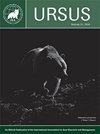水的供应限制了棕熊在其全球活动范围的南部边缘的分布
IF 0.8
4区 生物学
Q4 ZOOLOGY
引用次数: 25
摘要
大型食肉动物是世界上最受威胁的物种之一,因为它们的自然密度低,需要广阔的栖息地。棕熊(Ursus arctos)是亚洲西南部最大的食肉动物,在其大部分活动范围内都面临着与人类争夺共享资源的冲突和栖息地缩小的威胁。在这项研究中,我们在2013年4月至2015年11月期间,在24个随机选择的25平方公里网格单元中调查了棕熊的迹象和粪便,并在伊朗最南端的棕熊分布范围内建立了棕熊潜在发生的模型。为了更好地了解其在景观尺度上的保护需求和管理重点,我们结合实地调查开发了一个最大熵(Maxent)模型。该模型是使用10个环境和人为预测因子开发的。潜在棕熊的发生受水资源可得性的强烈影响(54.1%);与道路的距离(16.1%)、坡向(7.6%)和植被类型(5.9%)是其他重要影响因素。模型显示,研究区内有581 km2(35%)的区域具有高至良好的熊发生概率值;这个地区的86%分布在2个小块上,每个小块都比熊的平均活动范围大。确定这些斑块可能有助于在该地区建立保护区,这将确保棕熊的长期生存,并确保该地区居民和游牧社区对水的可持续利用和对大西洋黄连木森林的资源开采。本文章由计算机程序翻译,如有差异,请以英文原文为准。
Water availability limits brown bear distribution at the southern edge of its global range
Abstract Large carnivores are among the most threatened species in the world because of their natural low densities and need for expansive habitats. The brown bear (Ursus arctos) is the largest carnivore in the southwestern Asia, and faces threats in much of its range from conflict with humans over shared resources and shrinkage of habitat. In this study, we surveyed for brown bear sign and scat during spring–autumn from April 2013 to November 2015 in 24 randomly selected, 25-km2 grid cells, and developed a model of potential brown bear occurrence in one of its globally southernmost distribution ranges in Iran. To better understand its conservation needs and management priorities at the landscape scale, we used a combination of field surveys to develop a Maximum Entropy (Maxent) model. The model was developed using 10 environmental and anthropogenic predictors. Potential brown bear occurrence was strongly influenced by availability of water resources (54.1%) as the most important variable; and distance to roads (16.1%), aspect (7.6%), and vegetation types (5.9%) were the other important factors. The model showed an area of 581 km2 (35%) within the study area has high to good bear-occurrence probability values; 86% of this area is located in 2 patches, each larger than the average bear home range. Identification of these patches may support establishment of a reserve in the area, which would ensure long-term survival of the brown bear and sustainable water use and resource extraction from Pistacia atlantica forests by resident and nomadic communities in the region.
求助全文
通过发布文献求助,成功后即可免费获取论文全文。
去求助
来源期刊

Ursus
生物-动物学
CiteScore
2.00
自引率
15.40%
发文量
12
审稿时长
>12 weeks
期刊介绍:
Ursus includes a variety of articles on all aspects of bear management and research worldwide. Original manuscripts are welcome. In addition to manuscripts reporting original research, submissions may be based on thoughtful review and synthesis of previously-reported information, innovative philosophies and opinions, and public policy or legal aspects of wildlife conservation. Notes of general interest are also welcome. Invited manuscripts will be clearly identified, but will still be subject to peer review. All manuscripts must be in English. All manuscripts are peer-reviewed, and subject to rigorous editorial standards.
 求助内容:
求助内容: 应助结果提醒方式:
应助结果提醒方式:


